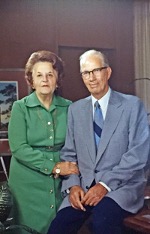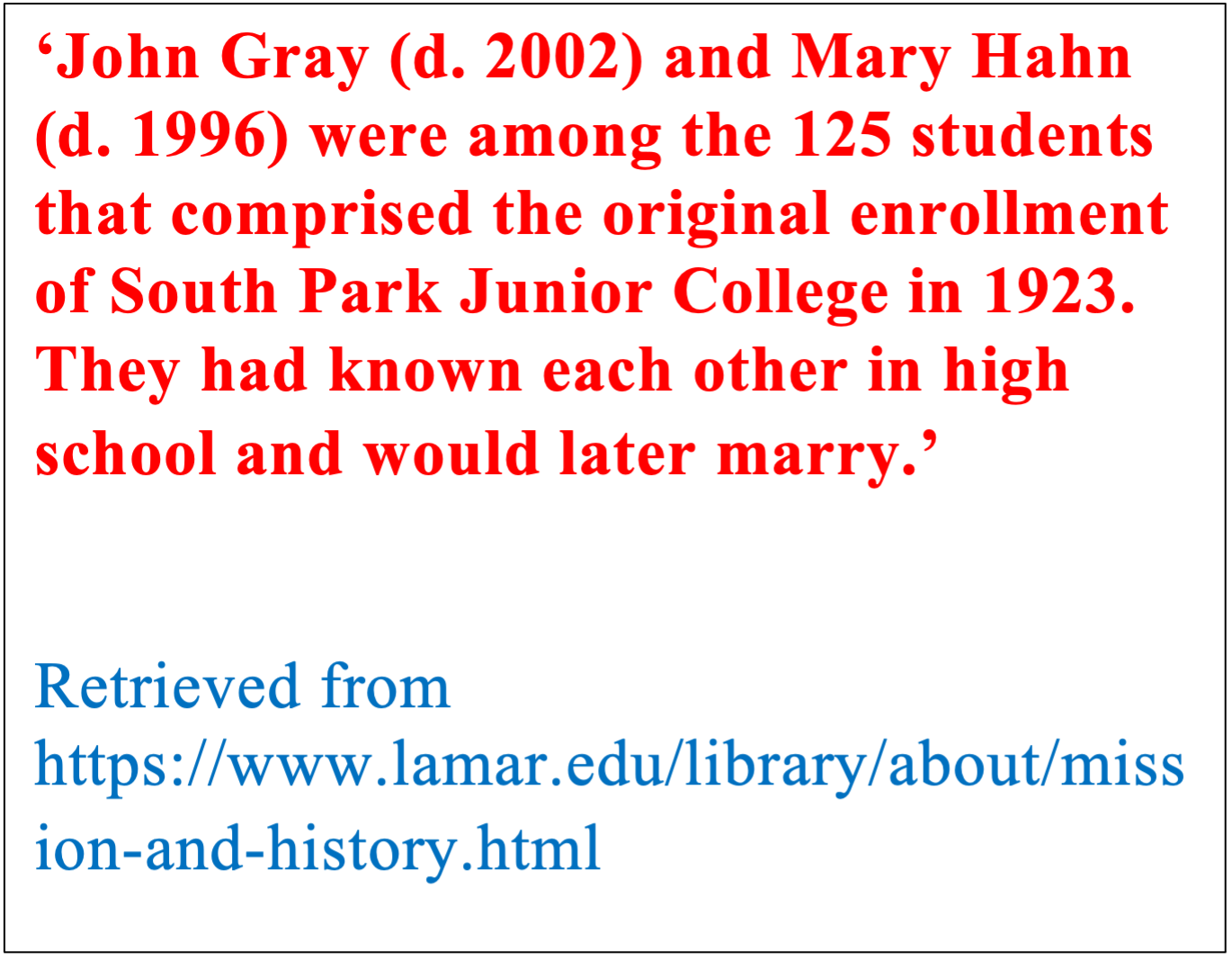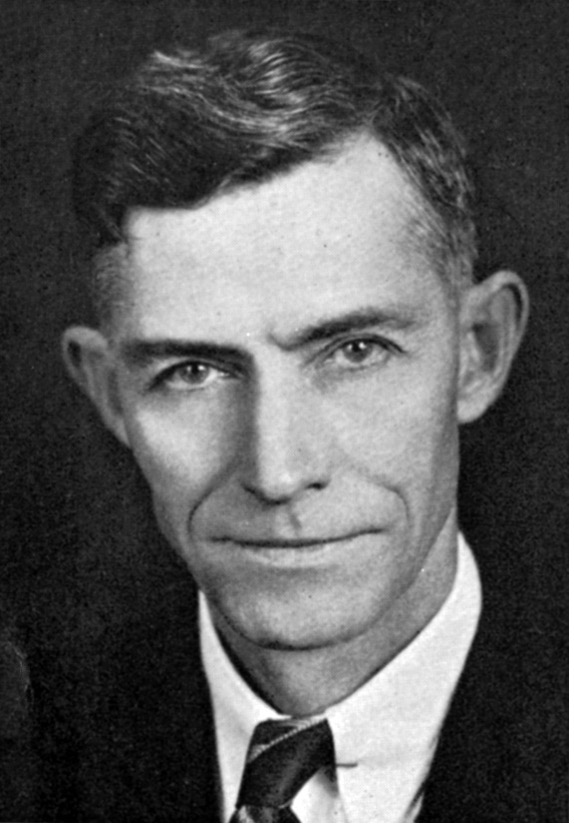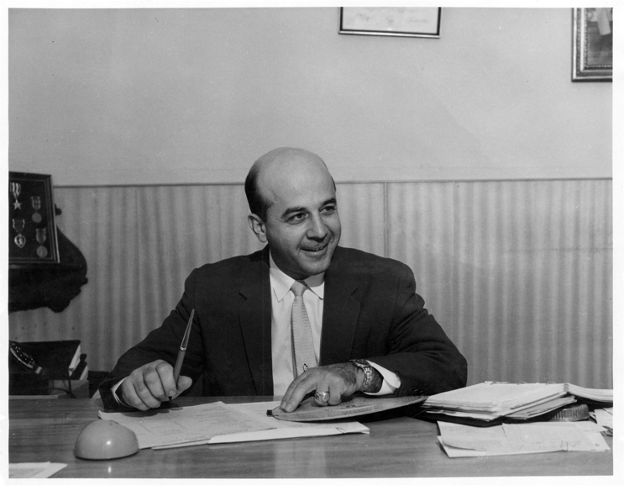President John Gray, Judge J.M. Combs (the Father of Lamar University), Mayor Jimmie Cokinos: Narrated By Ms. Penny Clark
Ms. Penny Clark is a Special Collections Librarian
Began working at Lamar University in 2009
Interviewed by Vidisha Barua Worley on 09/11/2023
‘I came to Lamar in 2009 and I have been here ever since. I got an opportunity to do a lot of very interesting things. I worked on the TSUS (Texas State University System) book, as it is a part of the larger Lamar system. So, it was my great privilege to work on that book. That was very interesting. I learned a lot about Lamar from that. That was a great opportunity. I got a lot of opportunities at Lamar to further my publishing. I have been able to write a book. It was about one of our collections here. During World War II the Germans knew that a lot of good Texas oil was leaving Texas ports. So, they would blow up ships that had Texas oil in them, because they realized it was so vital for victory. There was a loss of life and good old Texas oil. The US Navy was all over, they were doing so many things they didn’t really have a chance to guard the Gulf of Mexico and the Atlantic. They had to depend on civilians. Civilians were going on military missions and fly very low in very old airplanes. Four of them from Beaumont lost their lives. We have a really great collection of images of the civil air patrol. I wrote an Arcadia Press book. I had a chance to utilize all those photographs that belong to Lamar. I published a couple of articles based on Lamar. One, I call Glory Days which was about how the second Spindletop oil boom entered downtown. There are so many buildings, the Goodhue Building, the Courthouse, so many of our buildings, came about during the second Spindletop. It came in in late 1925, almost a hundred years ago. It started a building boom. I was so interested in that I called that Glory Days. I also did another which is about to come out, The Untapped Black Gold about our oilfield collection. It is coming out in the Oil Industry History, a publication of the Petroleum History Institute. Since I have been here, I have had a chance to travel to places like Wyoming and Pittsburgh, Pennsylvania and I have given about 20 presentations and really enjoyed doing it.'
'I have another article that’s coming out, I am hoping to publish in the Southwestern Historical Quarterly how Lamar through its leaders utilized the opportunities of World War II to build today’s Lamar University. I have an interest in the Civil War I really usually come back to World War II. I know war is a tragic horrible thing a lot of people lose their lives but it’s also a time when a lot of change in society like the role of women changes a lot. There is a lot more opportunities for women. So I usually come back to World War II. I had a chance to go to a lot of conferences. I met a man at a conference and he teaches at Mississippi. He’s an endowed chair and he said you really need to think beyond your telling the story but he said you’ve got the ability to try to work to publish in maybe higher places you know, challenge myself a little more and sometimes it is hard. It’s really an interesting opportunity.'
‘Any faculty at Lamar can use any of the special collections, and our University archives photo is free of charge to use a lot of them. We want people to know that we are a resource and you know if I had had to pay for all the photographs, I used in my book on the civil air patrol it would cost a lot of money. I always had a passion for history. I was a very late in life child and maybe my parents had more time to talk to me and tell me stories. They had lived through the Great Depression, World War II. They had memories that went way back and maybe they had a lot more time with me that they did with the other children and so I guess I heard a lot more stories growing up. I was always fascinated by history.’
‘Any faculty at Lamar can use any of the special collections, and our University archives photo is free of charge to use a lot of them. We want people to know that we are a resource and you know if I had had to pay for all the photographs, I used in my book on the civil air patrol it would cost a lot of money. I always had a passion for history. I was a very late in life child and maybe my parents had more time to talk to me and tell me stories. They had lived through the Great Depression, World War II. They had memories that went way back and maybe they had a lot more time with me that they did with the other children and so I guess I heard a lot more stories growing up. I was always fascinated by history.’


‘John Gray did some really terrific things like with the bank he was really doing Internet banking before anybody else. I came from a banking family. Very small town. I came from a town that had a population of 410 but anyway my family that had the bank they are and be part of our life was really interested one of my friends said would you research a building downtown and they wanted to make it a contributing part of the National Historic District and that time the building was not 50 years old. Here in the United States, I don’t think there’s often times a respect and appreciation for history. So, if you wait for a building to be 50 years old, it will be gone. He wanted it to be modern. It was definitely a modern building and John Gray was a big part of our history. I’ve been researching about how he worked with this man to move from just being on the third floor of South Park into having an independent college that wasn’t just dependent on South Park. During World War II, they had got a bond issue passed for money to build these buildings at Lamar and so they got $850,000 which was a lot of money.’

President John Gray in his office in the early 1940s. These pictures are from
the Special Collections of the Lamar University Library.
'There was a man I really admire Judge J.M. Combs. He said this should be a four-year institution and he said we should have a fabulous engineering program all of which came about. He had got $800,000 in the bonds in order to build the first buildings here at Lamar as an independent campus. But that wasn’t quite enough. Anytime you have a construction project you never have enough money and he needed more money so we found out the government would offer hundred thousand dollars if they would open a war training school. So, here at Lamar they opened a war training school and they operated 24 hours, since it started here, I believe in 1940. Some of this was before World War II but they were starting in 1939. There is the shipyard here and there’s a shipyard in Orange, both got huge government contracts. So, they were really gearing up for World War II in the late 30s here. Everybody knew the war was coming and the shipyard got huge contracts. And so, Judge Combs said, we’ve got to train our local young people for these jobs or they are going to bring people in from the East. He was a bright man and he had a vision for Lamar. They asked him do you have any hobbies and he said, Lamar is my hobby.
‘He had come up the hard way. His parents died when he was young and he was raised by his grandparents and his grandfather talked a lot about public service. The family had money but a panic had come through and they no longer had money and so he had to go and work in sawmills in the summer which is extremely hot, dangerous, dirty, but it was a way to earn money and he went to college to become a schoolteacher, then he read law night and he became a county judge in Hardin County when he was only 28 years old. So, he was really a remarkable person. Then when he came to Lamar, he had a vision: he said this should be a four-year institution, we should be on our own ground, we shouldn’t just be South Park. He had a vision for Lamar and all the things that he envisioned have come true.'
'I think I would like to see a statue of Judge J.M. Combs. I think he’s largely forgotten and he was obsessed in a positive way with Lamar. People at that time called him the father of Lamar. I think there should be a statue of him on campus because it was really his vision for being a four-year institution and for having a fabulous engineering program. Lamar owes him a big debt of gratitude.'

Judge J.M. Combs
‘There should be a statue of him (Judge J.M. Combs) on campus because it was really his vision for Lamar to be a four-year institution and have a fabulous engineering program.’
— Penny Clark
‘Judge Combs, the father of Lamar mandated the money. Judge Combs is a quintessential first-generation success story. His family had a lumber business and they were selling really brilliant virgin lumber that had never been cut down for pennies on the dollar. His grandfather said that I am not taking out bankruptcy I am not leaving people holding the bag …I am going to pay these bills. Then when Judge Combs got to be age to go to college he wanted to go to college he had to go and work in saw mills, very dangerous work. He made enough money that he could to college. He got a teaching certificate and then he said well that’s fine, but I would really like to be an attorney. So, he read law at night and when he was 27, he ran for County judge in Hardin. He won the election and then he came to Beaumont became a judge and was on the board of directors at what was South Park junior-college and he said we shouldn’t just be doing the hard physical lifting, he said we should be engineers. He said, this should be a four-year institution. We should really focus on building a fantastic engineering department. He renamed South Park as Lamar who was the president of the republic of Texas and he was a big believer in public education. John Gray is the person who changed it …to the Cardinals, he changed the colors so they set off on a new focus and then during World War II, they were trying to build this new college.’
‘Judge Combs called and said I’m running for the election… They didn’t have enough money to complete. They were going to start with five buildings including the Galloway building and things like. You know how it is with the construction work, you never have enough money. So, he heard that the federal government was offering grants if you would open a war training school, in other words train people to work in wartime industries, they would give you a grant of $100,000. Combs was just on that. So, first he went to Fort Worth and he delivered his grant proposal and they turned him down. He made some changes and resubmitted it, then it went to Washington DC and they still said no, we were not going to give you the money and so then he said I will change it again. They opened a war training school and they were operating 24 hours a day training people to work in wartime industries. They trained eventually 17,000 people. It is really a fascinating era. This is the first time that women in most cases are working outside the home. I always think it’s so wrong. Some women with eight children and they come down and they list their occupation as nothing for not working outside the home. Combs is somebody I really admire and I always said we wouldn’t be standing here today if it wasn’t for Judge Combs. He really is the person that recognize that we shouldn’t just have hard physical labor in this place, we should have a fabulous engineering program. He’s one of the people that I really look up to in the history. Of course, there are so many different people who have made their contribution.’

Mayor Jimmie Cokinos
‘Jimmy Cokinos is really a hero. He later won awards for his work.
He is a very important figure in Lamar’s history.’
He is a very important figure in Lamar’s history.’
‘White people that were protesting, they were blocking entrances so African-American students couldn’t attend. When you don’t let people enter the college that is really a wrong thing. So, first he (Jimmie Cokinos) went back to the City Council and he said we need to do something about it. At the city Council really nobody was interested in taking action and then he went down to the police department and he talked to the chief of police and the chief of police did come out there and they did break it up they did arrest some of those people. They came to what’s now the Julie Rogers theater because he was Mayor, and then they started protesting around this what was then City Hall and they actually eventually they went down and they firebombed the church he attended. He said he did have guards but he knew a lot of the guards were segregationist they weren’t sympathetic to what he was trying to do. He lived to be 97 years old. He was of Greek descent. His father came from Greece and really pushed his children I don’t know what the daughter did but all four of the boys graduated from Beaumont High School and then they went on to Texas A&M and all graduated and then they all had really interesting important careers. Jimmy Cokinos is really a hero. He later won awards for his work. He is a very important figure in Lamar’s history.’